Content Production in Agencies in DACH - Survey 2023
Patrick Meier
Co-founder
The survey conducted in the summer of 2023 revealed that the volume of content to be produced has increased significantly over the past years and will continue to grow, largely driven by social media content.
Around three-quarters indicated that at least five or more people are involved in their content production, and they have established processes for collaboration. However, only 30% of the respondents consistently adhere to these processes.
Microsoft and Google Office Suites dominate software usage, supplemented by a quarter of respondents who rely on project management tools. Specialized content collaboration solutions are rarely used.
The majority of the surveyed agencies believe they work efficiently. Yet, more than 70% think there's room for improvement. When asked about challenges, about 40% most frequently mentioned workflows and processes.
With 69 participants, the survey provides meaningful results. Of course, interpretation is essential to draw conclusions.
What type of content is primarily produced?
Content production is steadily shifting towards social media, which now stands on an equal footing with web content. This is not surprising given the nature of this channel: Social media thrives on constantly new content. Display advertising is found at the end, which is also due to the characteristic that displays can be used for a longer time.
Search engine marketing retains its relevance. But for how long? With developments like ChatGPT, its importance could diminish. At the same time, unique, relevant content is gaining in value. On the one hand, as "food" for AI, and on the other hand, it creates and maintains attention in the constant competition for users' time.
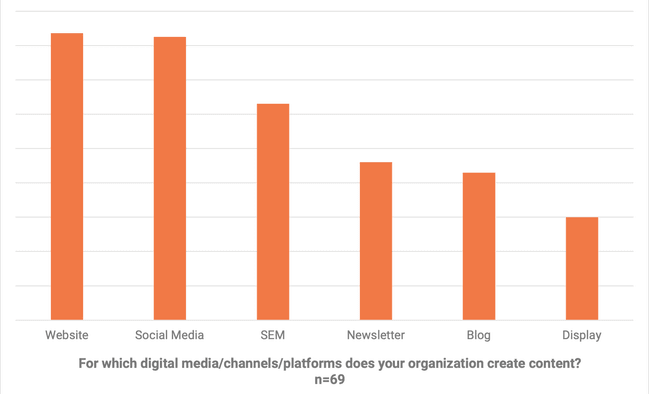
How has the volume of content to be produced changed over the past five years? And what does the future look like?
The picture is very clear: More than 95% of respondents confirmed that the volume of content has increased, with around 60% indicating that it has increased significantly.
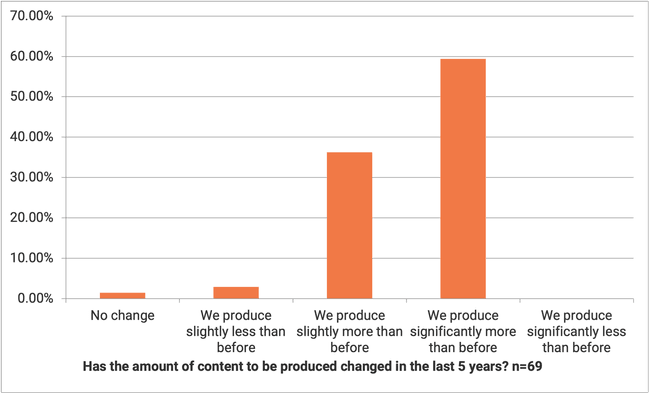
Content Production: change of volume When the respondents look to the future, they anticipate a further increase in the volume of content to be produced. Perhaps not quite at the same magnitude as the last five years, but more than 85% of responses expect a continued rise, with about a third of all answers even predicting a significant increase.
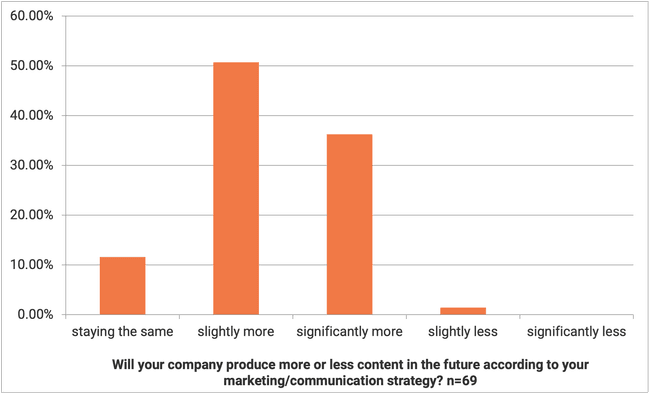
How many people are involved in the production process?
How many people are involved in the production process? Around a quarter of respondents indicated that only one to two people are involved in the production process. This is expected for agencies that primarily specialize in one discipline or where individual employees take on various tasks. For about half, it's two to five people, reflecting the typical composition of content production: text, graphics, project management, client. When languages or, for example, legal checks are added, the number of participants rises above five, which was the case for the remaining quarter of those surveyed.

Is software used to support the production process?
The use of software is a given. The interesting part is the type of software being used. Here, over 50% of the responses are dominated by users of the traditional office suites from Microsoft and Google. A second group, comprising 24%, uses project management solutions like Trello, Asana or Jira.
Only a small group uses specialized content production tools such as GatherContent or EasyContent. And one agency – likely due to a lack of suitable options – has decided to develop its own solution.
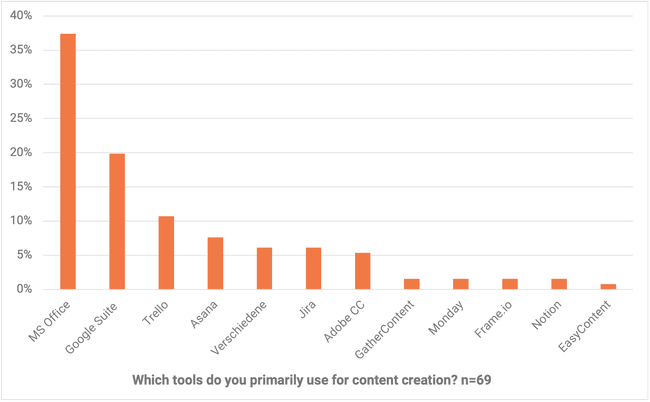
Does your company have standardized and established workflows for content creation?
A third of respondents state they have established processes in place and adhere to them. Nearly 44% do have workflows, but struggle to consistently follow them. And almost a fifth indicate they have not implemented clear processes.
What this analysis does not reveal are the reasons for each situation. It raises the question of whether the lack of adherence to processes stems from a lack of tools that could support these processes.
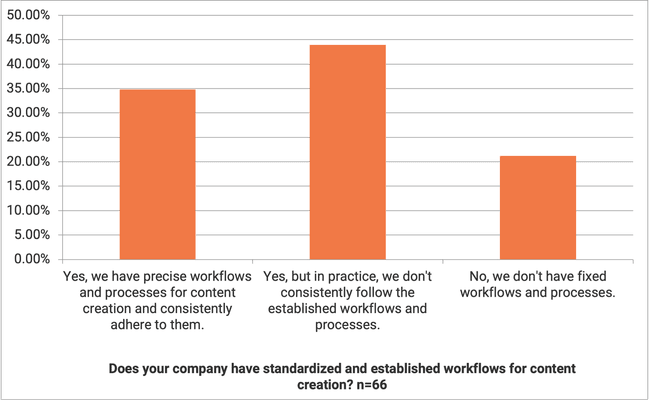
This leads to the question of what the respondents see as the biggest challenges related to content production.
Finding qualified personnel is a persistent challenge in the communications industry, affecting a third of the respondents. It's interesting to note that over 40% of respondents, the largest group, indicate that processes and workflows in content production are a central issue.
The fact that only about 20% of respondents perceive a lack or suboptimal software as a challenge suggests that they only see a partial correlation between processes and software.
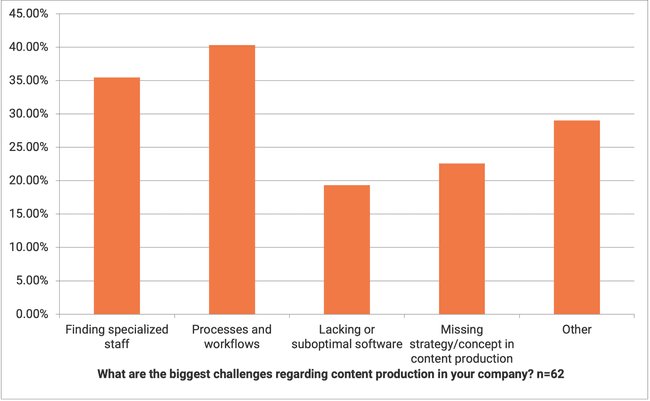
How efficient is content production?
In conclusion, we wanted to know from the respondents whether they assess their content production as efficient. Small proportions, each at around 15%, rate their efficiency as either comprehensive or as lacking. The vast majority, close to 70%, assess their own performances as efficient but simultaneously believe that improvements are possible.
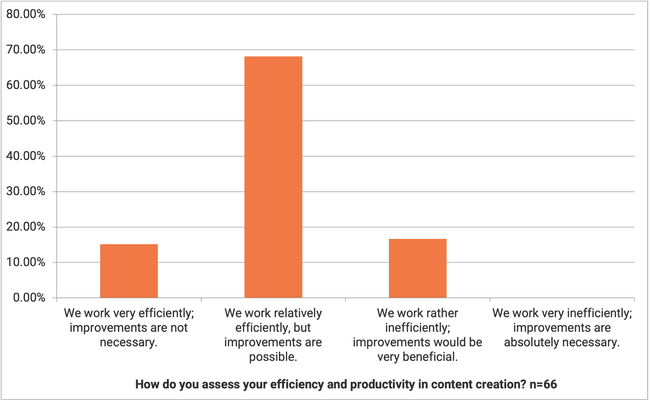
Survey: Data Basis
The sample consists of 85% agencies such as creative, PR, digital marketing, media, or social media agencies. A good third of the responses came from agencies with 1 to 5 and another third from those with 6 to 15 employees. Another 20% are from agencies with 16 to 50 employees, with the remainder from larger organizations. In over 90% of cases, responses were provided by executive board members.
A big thank you to all participants who made this survey possible!